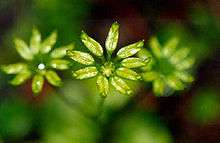Coptis
| Coptis | |
|---|---|
 | |
| Coptis occidentalis flowers | |
| Scientific classification | |
| Kingdom: | Plantae |
| (unranked): | Angiosperms |
| (unranked): | Eudicots |
| Order: | Ranunculales |
| Family: | Ranunculaceae |
| Genus: | Coptis Salisb. |
| Species | |
|
See text | |
Coptis (Goldthread or Canker Root) is a genus of between 10–15 species of flowering plants in the family Ranunculaceae, native to Asia and North America.
Species
- Selected species
- Coptis aspleniifolia
- Coptis chinensis
- Coptis deltoidea
- Coptis groenlandica
- Coptis japonica - Huang lian in Chinese (Chinese: 黃連; pinyin: Huang lian)
- Coptis laciniata
- Coptis occidentalis
- Coptis omeiensis
- Coptis quinquefolia
- Coptis quinquesecta
- Coptis teeta
- Coptis trifolia

Uses
Coptis teeta is used as a medicinal herb in China and the Eastern Himalayan regions of India particularly in Mishmi Hills of Arunachal Pradesh where it is used as a bitter tonic for treating malarial fever.[1][2] dyspepsia.[3] It is also believed to help insomnia in Chinese herbology. The roots contain the bitter alkaloid berberine [.[4] Studies have shown that the species has become endangered both due to overexploitation as well as intrinsic genetic bottlenecks such as high male sterility induced by genetic mutations.[5][6] As a result of the synpatic mutation and ensuing male sterility the sexual reproduction in the species is significantly depressed [6] The dried roots (goldthread) were commercially marketed in Canada until the 1950s or early 60s, to be steeped into a "tea" and swabbed onto areas affected by thrush (candidiasis) infection.
Ecology
The species inhabits warm and cold temperate forests of oak-rhododendron association.[2] It is occasionally seen growing under bamboo thickets around Mayodia region of Dibang Valley district in the Mishmi Hills of Arunachal Pradesh in India. It flowers during early spring March–April and sets fruit/seed in July–August. The seedlings are rare and are often found germinating on moss laden dead wood on the forest floor or even on moss laden branches of Rhododendron. A new subspecies was recognised in C. teeta by Pandit & Babu and was named as subsp. lohitensis, which is morphologically very different from subsp. teeta and it is geographically distinct and inhabits broad leaf forests in Delai Valley of Lohit district in Arunachal Pradesh, India.[1]
References
- 1 2 Pandit MK, Babu CR , 1993. The cytology and taxonomy of Coptis teeta Wall. (Ranunculaceae) [J ] . Botanical Journal of Linnean Society , 111 : 371 —378
- 1 2 Pandit MK, Babu CR , 1998. Biology and conservation of Coptis teeta Wall.2an endemic and endangered medicinal herb of Eastern Hi2 malaya [J ] . Environmental Conservation , 25 (3) : 262 —272
- ↑ Huang, J.; Long, C. (2007). "Coptis teeta-based agroforestry system and its conservation potential: A case study from northwest Yunnan". AMBIO. 36 (4): 343–49. doi:10.1579/0044-7447(2007)36[343:CTASAI]2.0.CO;2.
- ↑ Pandit, 1991. Biology & Conservation of Coptis teeta Wall. (Ranunculaceae). Ph.D. Thesis, University of Delhi
- ↑ Pandit, M. K. & Babu, C. R. (2000) Bot. J. Linn. Soc. 133 , 525–533.
- 1 2 Pandit, M. K. and Babu, C. R. 2003. “The effects of loss of sex in clonal populations of an endangered perennial Coptis teeta (Ranunculaceae),” Botanical Journal of the Linnean Society, vol. 143, no. 1, pp. 47–54.
External links
